I’m so focussed these days on promoting Italian Rustic and One Book Press that I haven’t had much time to think about anything else. But this past week I’ve been talking to the owner of Bellezza, in Boston, about coming to town to talk about Italian Rustic. If you don’t know about it already, Bellezza is an incredible source for Italian ceramics. And while I’m thrilled that I will be visiting there at the end of March, to talk about Italian Rustic, it also made me kind of sad since I would have loved to sign copies of my first book, Deruta: A Tradition of Italian Ceramics. This book,which I wrote for Chronicle in 1998, is just about the only book available on Italian majolica. Or I should say was. It is out of print, and at the moment Chronicle has no plans to reprint it. And that’s why I’m sad.
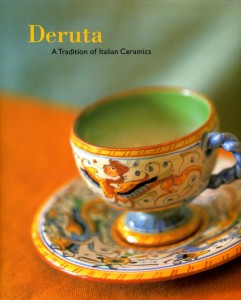
There are a few wildly expensive, out-of-print copies of Deruta available on Amazon. But since what so many people want to know where to shop once in Deruta, (there are over 300 stores and workshops!) I thought that it was time I devoted a blog to this. And these gorgeous photos? They are from the book, and were taken by the extremely talented Susie Cushner, who
photographed Deruta under the expert
guidance of designer Melanie Doherty.
Many of my friends freely admit to having a Deruta addiction. These cravings usually date from the time they bought their first small dish. To those of you who are about to be introduced to this highly seductive craft: be forewarned. The descriptions you are about to read and the photos you will see may cause deep cravings, severe fantasizing and an un stoppable urge to bring these objects into your home.
I remember the first time I heard the word “Deruta”. I had come to Italy to research a dissertation on Renaissance gardens. While diligently digging through mountains of dusty sixteenth century documents in Florence, I would daydream about weekend getaways. When a friend suggested we head for Deruta – a small village, just south of Perugia – I naturally assumed we would visit a church or two, admire some frescos, and make a stop in the local museum. Only years later, when I finally made the pilgrimage to this small Umb
rian village, did I realize it wasn’t high-minded sightseeing my friend had in mind, (although that was part of it) but rather some serious ceramic shopping!
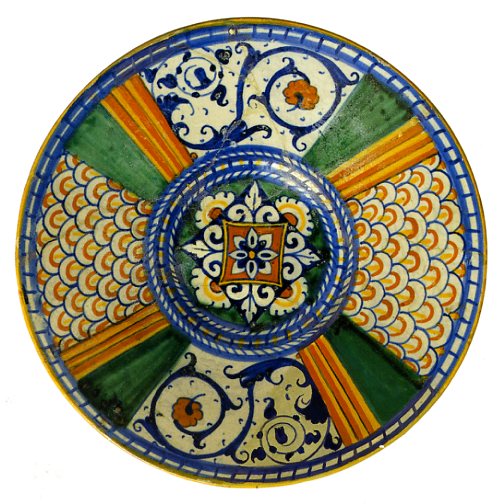
Still, history is an integral part of the Deruta experience. Those familiar with Italian ceramics will have already heard of Deruta. Along with other small towns throughout Italy, like Vietri and Grottaglia, Deruta is one of the biggest producers of the glazed Italian ceramic ware known as majolica. Deruta, however, stands out, since unlike other centers of this age-old craft, it has been producing majolica of high quality for over six centuries without interruption, and continues to do so today. It is this continuous and ever-developing history that informs the majolica from Deruta and distinguishes it from
other cities. It is this sense of history that is acquired when we bring a piece of Deruta ceramics into our homes today.
While the apex of the town’s production was in the sixteenth century, Deruta’s kilns, once lit, never went out. The craftsmen that first developed the brilliant glazes in the fifteenth century passed on their knowledge and innovations in both form and patterns to future generations. One of the most attractive things about
contemporary Deruta pottery is this sense of history. There are more than three hundred ceramic firms in Deruta today, making it one of the biggest ceramic producers in Italy. But if quantity may ring of impersonalized industrialization of a craft, the briefest of trips to Deruta dispels this view. This little town is a place where the human touch is always in evidence. The hand-crafted element conveys itself in the shapes, textures, and colors of the finished works.
At first glance there seems more that unites the diverse potters of Deruta than differentiates them. To the untrained eye, the stores start to look dismayingly familiar after a while. One aspect that does lend an overall homogeneity t
o the production is the trio of patterns which show up in just about every bottega, be it big or small. Most
firms, whether they concentrate on one-of-a-kind collectors pieces or simple sets of dinner ware, tend to keep in stock a good
selection of pieces featuring some variation of the patterns Arabresco, Gallo Verde
and Raffaelesco. All three patterns are descendants of patterns from the sixteenth and seventeenth centuries.
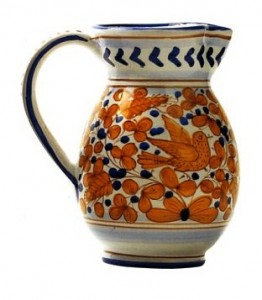
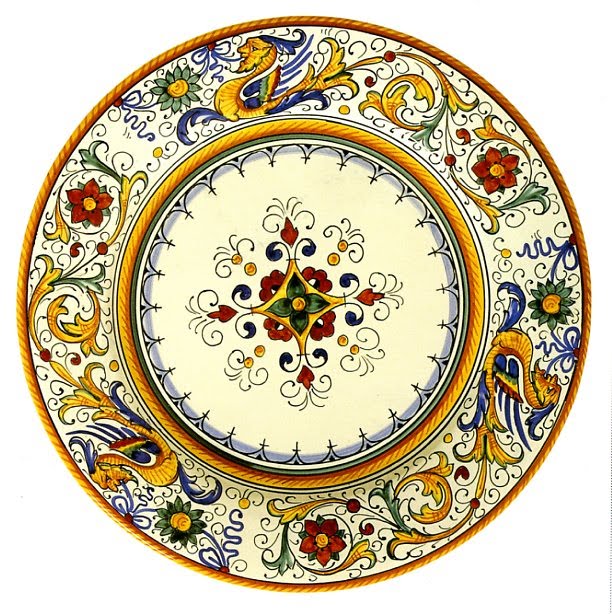
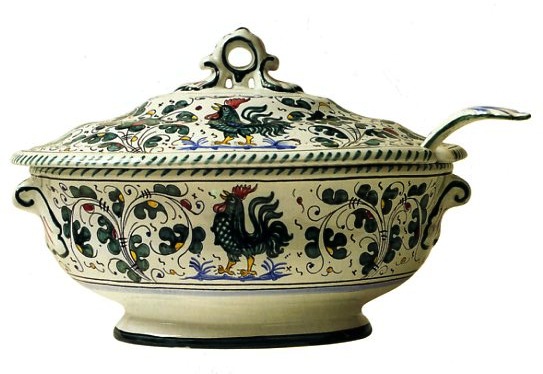
Although many of the same patterns are produced by most firms, there are subtle differences. Differences in the quality of both the material (glazes and clay) as well in the skill in design and draftsmanship are reflected in the finished product. The more amount of time spent on a piece is naturally reflected in a higher price.
No matter the size of the studio, most are able and willing to accept special orders. In fact, one of the joys of visiting Deruta is the chance to sit down with a maestro and work out your own special pattern, whether it is simply a color variation of a traditional model, or a set of plates incorpora
ting your family coat of arms. And all but the smallest firms are well versed in the complexities of shipping things back home.
It is very difficult to single out specific studios to visit… but of course I have my favorites!
Most trips to Deruta begin at the turn-of-the-century Grazia factory.
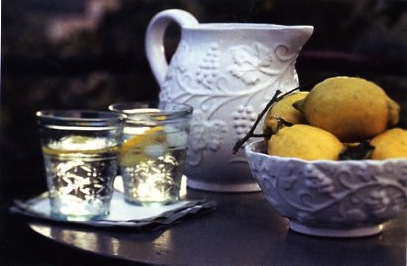
The Grazia factory is the only one to still work it’s own clay, from powder to the finished product and the large and airy decoration room is the training ground for many of the artisans who later strike out on their. While Grazia’s repertoire includes richly colored and intricately painted patterns such as Ricco Deruta, which carry on Renaissance rhythms, my personal favorite is the pure white Uva Bianca. But be forewarned: Grazia’s prices are astronomical and the waiting list for a set of dishes is sometimes up to two years!
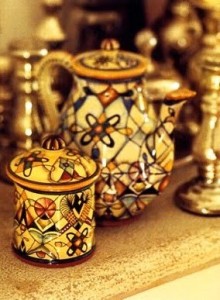
Franco Mari,down the road, has developed a unique set of patterns based only loosely on sixteenth century motives, and spiced into lively new combinations with patterns and colors seen during his travels. “Anasazi” takes American Indian sand paintings as its cue, tracing them on exquisitely formed coffee and tea sets. A distinguishing characteristic of Mari’s work are his glazes. They are always rich and saturated with a smoothness and brilliance, and an almost glasslike finish, that is unique to his ware. This final transparent glaze is a family secret, which Mari inherited from his father. And don’t fear if you can’t decide on a specific pattern for your dinner set do what my friend Ruth did: make up a set where each setting features a different pattern!
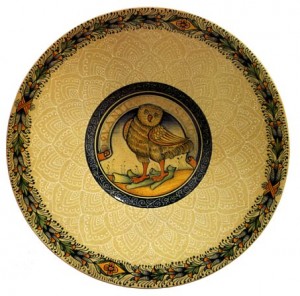
One of the great masters in town is
Antonio Margaritelli. From the exterior, Antonio Margaritelli’s store looks like many of the other low-slung, new buildings that line the Via Tiberina. Located just past the only stoplight in town, the modern
building is fronted by a sloped parking area. But once you step through the glazed doors, the differences from the other shops around town are immediately apparent. No Gallo Verde pattern here; in fact, the first display cabinet contains a collection of antique objects not even for sale. Revealing his inspiration, the most prized of Margaritelli’s enormous collection of Renaissance fragments are proudly displayed, many rivaling those on view in the museum nearby.
Margaritelli sets out to capture the fascination and beauty of these sixteenth century fragments. Through painstaking research and experimentation, he has
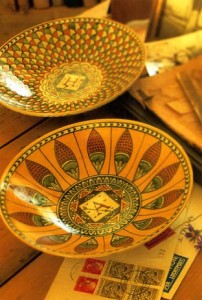 rediscovered the old formulas for glazes, using pigments he digs up himself, in the surrounding hills. His exquisite production is extremely low, and he produces only a few hundred pieces per year, each one unique. All are rigorously based on antique patterns and are often hard to distinguish from the real thing. While his larger plates, meant to hang on the wall, require a
rediscovered the old formulas for glazes, using pigments he digs up himself, in the surrounding hills. His exquisite production is extremely low, and he produces only a few hundred pieces per year, each one unique. All are rigorously based on antique patterns and are often hard to distinguish from the real thing. While his larger plates, meant to hang on the wall, require a
substantial investment, I have started a collection of his coppe amatorie, or loving cups. Traditionally given to each other by lovers, these small plates bear the initial of the giver.
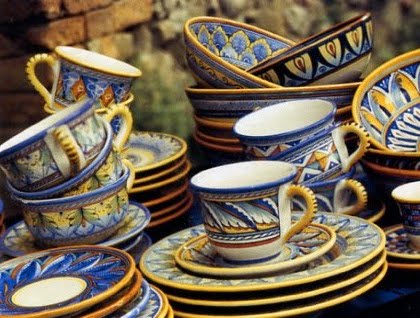

If it’s a set of mugs you want, or a brightly colored setting to use at breakfast, without worrying too much about chipping, then Sberna is your best bet. Located across the street from the more imposing Grazia, the Sberna sisters, Anna and Franca, are more than willing to help you choose from the almost overwhelming stacks of merchandise. While most of the designs are classical Deruta, they offer a refreshing array of more contemporary designs, developed by visiting designers from the United States. Of all the places in Deruta, this is where I come, again and again, to buy serving dishes, gifts and – as my sisters well know – complete sets of dinner plates as wedding gifts!
Sources in Deruta
There are over three-hundred ceramic studios in Deruta, reflecting a wide variety of styles, merchandise, and quality. A full listing of the firms in Deruta can be obtained at the tourist office in the main square. The following are my personal favorites:
Via Umberto 1, 19
Tel: +39 075-971-0747
Exquisite one-of-a-kind masterpieces.
Via Tiberina Centro 181
Tel: +39 075-971-0201
Via Tiberina Centro, 146
Tel: +39 075-971-0206
Antonio Margaritelli
Via Tiberina 214
Tel: +39 075-971-1572
No web site! He barely has a telephone. Just go! But if you can’t make it, Bellezza carries his work.
Franco Mari
Via Tiberina, 236
Tel: +39 075-971-1224
He has a useless web site, but you can see (and buy) a lot of Mari’s work at Biordi.
PHOTOGRAPHS: The gorgeous photographs were taken by Susie Cushner, and are copyrighted by her. They originally appeared in our book, Deruta.
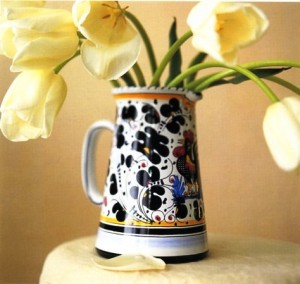
Dear Elizabeth,
I discovered Deruta pottery during a visit to Florence in 1996 and when your book, Deruta, A tradition of Italian Ceramics came out, I purchased it and have loved it like a piece of pottery itself. Thank you!
Now, 14 years later, I am finally headed to Deruta! In late April, my husband and I are going to visit friends in Naples and then taking a long weekend trip to Deruta and Assisi.
I will take along notes about specific artists from your book and blog and hope to find the two sisters who created the pates I purchased those many years ago. I was only told they were sisters (perhaps the same ones you mentioned?). One plate is signed with the name: Marisa.
Thanks again for so eloquently sharing the beauties of Umbria, you have prepared me for a wonderful experience!
Susan
Dear Elizabeth
I lived in Deruta for over 10 years and worked with the wonderful family of Assunta Galli and Gerado Ribigini. Their company is called Geribi. They have beautiful quality and a great website, http://www.geribi.com.
Thank you
Jo
Hi Jo,
Thanks for commenting. I know and love Geribi! If I had known about them when I wrote the book, I certainly would have included them. These days I always try to stop by when I am in town.
Elizabeth
These are amazing peices, I always turn a plate over to see where it’s from, Italian and old English are my faves.
i am planing to spend a weekend with my family and want to cook something special for my wife as a gift.